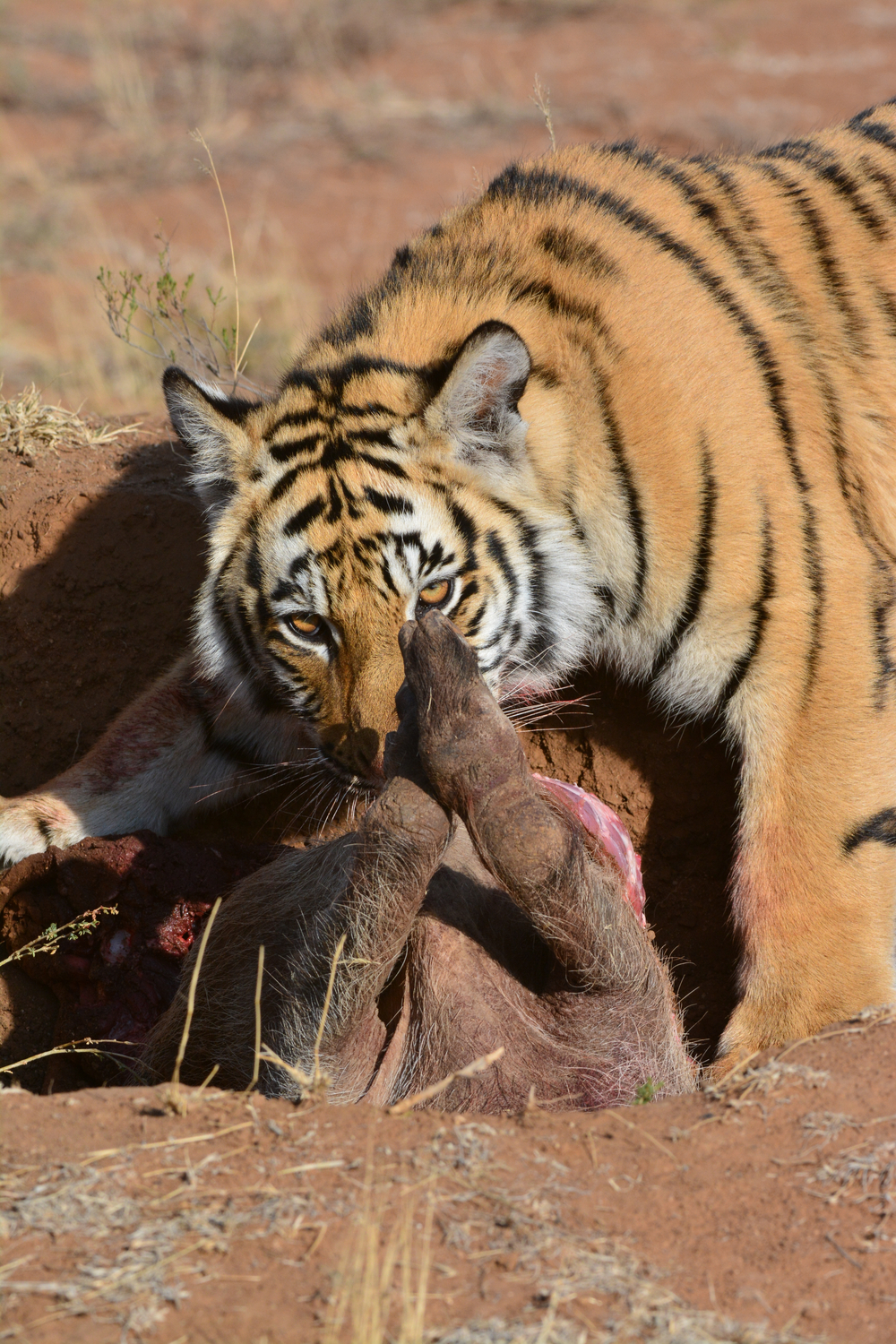As the world’s largest wild cat species, and perhaps even the most beautiful, the tiger habitat is one to be admired, but it needs our help.
Shere Khan, the ferocious Bengal tiger in Rudyard Kipling’s “The Jungle Book,” offers a simplified depiction of the human impact on nature.
Tiger Habits and Biology
Tigers are easily recognizable by their orange-brown fur and unique set of dark stripes. Tiger stripes are skin-deep and double as a unique identifier, similar to the human fingerprint.
Unfortunately, prize-hunting and habitat loss has exploited these beautiful cats, thus creating a significant population deficit over the years.
Three species have become extinct, leaving the Bengal tiger, South China tiger, Indochinese tiger, Sumatran tiger, and the Amur tiger (Siberian tiger).
These magnificent beasts can measure up to 3.3 meters in length and weigh up to a whopping 660 pounds. The largest species is the better known Siberian tiger; however, the Bengal tiger is most numerous.
For the most part, tigers lead solitary lives and are known for their incredible hunting prowess. Despite their weight, tigers can reach speeds of up to 65 kilometers per hour.
Tigers are carnivorous (meat-eaters) and capable of eating almost anything that comes their way. For the most part, tigers enjoy feasting on large mammals, including deer, buffalo, antelope, and wild pigs, but a sweet delicacy like fish, birds, or occasional crocodile is equally appreciated.
A tiger’s sheer strength could kill its prey with one swipe from its front paw. Its love and appreciation for swimming also give tigers the ability to hunt in the water.
Newborn tiger cubs are blind, so they follow the scent of their mothers until they have full vision, generally within a couple of weeks. Sadly enough, the mortality rate of young tigers is relatively high.
Although fires, floods, and predators present quite a risk to the young, cubs can also die from hunger or cold. In some cases, a male tiger may even eat the cubs for mating predominance.
If the cub survives to maturity (around 24 or 30 months of age), it will have developed the hunting skills necessary to go out on its own.
What Do Tigers Eat in the Wild
Tigers quietly stalk their prey, sometimes for hours, until they deliver that deadly POUNCE!
Interestingly enough, tiger cubs fall under the apprenticeship of their mother’s skills before being allowed to hunt independently.
As a result, tigers usually hunt alone rather than in groups. In addition, male and female tigers tend to hunt differently. While females stay close to home, male tigers venture out more.
Tigers can easily consume between 35-110 pounds of meat at a given time. Therefore, depending on the size of its meal, a tiger may eat once every two days.
If we take a closer look at the inside structure of the tiger, the design of its skull is quite fascinating. A tiger’s skull protects its eyeballs and brain and includes a septum made from hard bone, which invests superior power into its teeth and jaws.
Even though tigers have fewer teeth than the average human being, each tooth is specialized in clamping and tearing away at the meaty flesh of its prey.
A tiger knows that it may not always get a catch. Statistics show that a tiger may make up to 20 attempts before making a kill.
It is likely because of this that these large felines are less picky about what they eat. Tigers won’t even mind scarfing up the rotting pieces of flesh left behind after a two or three-day-old hunt.
Besides the design of their skull, large teeth, and speed, tigers have several physical features that assist in the hunt. From their retractable claws, acute hearing, and outstanding night vision, tigers have a significant advantage over most of their prey, thus classified as apex predators.
Tigers also prefer to hunt on cool, cloudy days or when the sun is setting. However, tigers will not let a prime opportunity pass, no matter the condition. This behavior is brilliant as most animals are winding down after a long day of grazing.
Depending upon its region, tigers are most attracted to bigger prey (means more meat), including:
- All species of deer, especially the sambar, sika deer, and nilgai
- Other felines
- Wild bison and buffalos
- Boars and wild pigs
- Zebras
- Tapirs
- Horses, antelopes, and wild cattle
- Rhino calves
- Young elephants
- Moose
- Crocodiles
The tiger will settle for smaller mammals if large prey is not available. Its significantly smaller yet still satisfying fare may include specialty dishes such as:
- hares
- rodents (beavers, mice, squirrels, and rats)
- frogs
- snakes
- birds
- monkeys
- fish
- lizards, and
- termites
If a tiger goes hungry for too long, it will even eat berries or grass in an attempt to keep its digestive systems regulated.
Due to their active lifestyles, tigers require a high fat and protein diet to sustain optimal health. In addition, vitamin A and the amino acid taurine also significantly affect the health of these giant feline creatures.
Tigers are mesmerizing animals, and we should be grateful for the progress made in conserving this feline’s remaining species.
Interesting Facts About Tigers
In general, tigers can live up to approximately twenty-six years of age. In captivity, these large cats usually fair much better than their wild brothers and sisters.
A tiger’s lifespan may be reduced significantly in the wild due to exponentially higher risks, including fires, starvation, illegal poaching, retaliatory killings, and habitat loss.
Habitat
Tigers live in various habitats, including dry and wet forests, swamps, savannahs, and other grasslands. Over half of the remaining global tiger population resides in India.
In addition to India, tiger populations exist in China, Korea, Russia, and small pockets around Southeast Asia. Tigers can adapt to different habitats relatively quickly; however, the minimum requirements are shelter, food, and water.
Hunting
Starting at about eight weeks of age, the tiger cub leaves the den for the first time to begin receiving loving instruction on the skills necessary to survive in the wild.
In the beginning, cubs will follow along on the hunt and look on as their fearless mothers cleverly stalk and its intended prey. Then, as the mother watches her cubs mature in later months, she may even allow the little ones to finish off the kill.
Once the cub reaches eighteen months of age, the mother tigress begins to recognize her proteges as accomplished hunters as they continue to practice their trade.
By the time tigers are two years old, they are ready to leave the safety of their mother’s dens. Male tigers are typically more adventurous and wander further away, whereas the females will create their own tiny home close to their mother’s territory.
Tigers also possess the skill of mimicry and lure innocent animals such as the sambar (deer species found in India) to a surprise ambush.
As tigers plan their attack, they consider how best to ambush their prey from the rear or side. For example, a tiger may use its powerful hind legs to reach its maximum speed or even jump forward more than 30 feet to help secure its meal.
Communication
Even though tigers prefer to lead mostly solitary lives, they still communicate effectively in several different ways. If those large 3-inch-long teeth don’t say enough- I don’t know what will.
In addition to its body language, a tiger can let out an impressive roar which you can hear over three kilometers away.
At the non-aggressive level, tigers also communicate vocally by prusten, used to comfort one’s cubs or to establish a non-threatening entrance amongst other tigers.
Tigers can also use scent and body contact for courting and mating purposes. Female tigers experience approximately sixteen weeks of gestation, usually yielding two to four cubs.
Illnesses
A range of illnesses can afflict tigers, whether from an animal bite or consumption of its infected prey.
- Rabies
- Feline Aids
- Feline Leukemia
- Mange
- Tick Bite Fever
- Distemper
- Anthrax
- Tuberculosis, and
- Rinderpest
Specialized doctors can treat and vaccinate tigers given the opportunity. For specialized treatment, tigers must be taken out of the wild and then must undergo rehabilitation.
Conservation
Although the tiger represents strength and power and continues to play a symbolic role in the cultural identities of several Asian nations, its conservation lies in the hands of human beings.
Unfortunately, the tiger’s life has been susceptible to the political and economic vulnerability of some of the poorest nations on earth. Even in modern times, the situation has not changed much.
The illegal interest in this feline beast mainly revolves around medicinal folklore, a status symbol for wealth and dominance, but most of all, just pure greed with an absolute disregard for life.
Illegal poaching is a huge threat that continues and is a massive point of debate amongst the conservation community as corruption painstakingly surfaces at every turn.
Summary
Tigers are magnificent predators that deserve protection from unnecessary abuse and killing.
I urge you to research the many conservation organizations that actively aim to protect and conserve a feline species that dates back as early as possibly two million years ago based on fossil evidence.
Comment below with any questions or concerns regarding the tiger’s life and how you can do your part to ensure its species live on.



